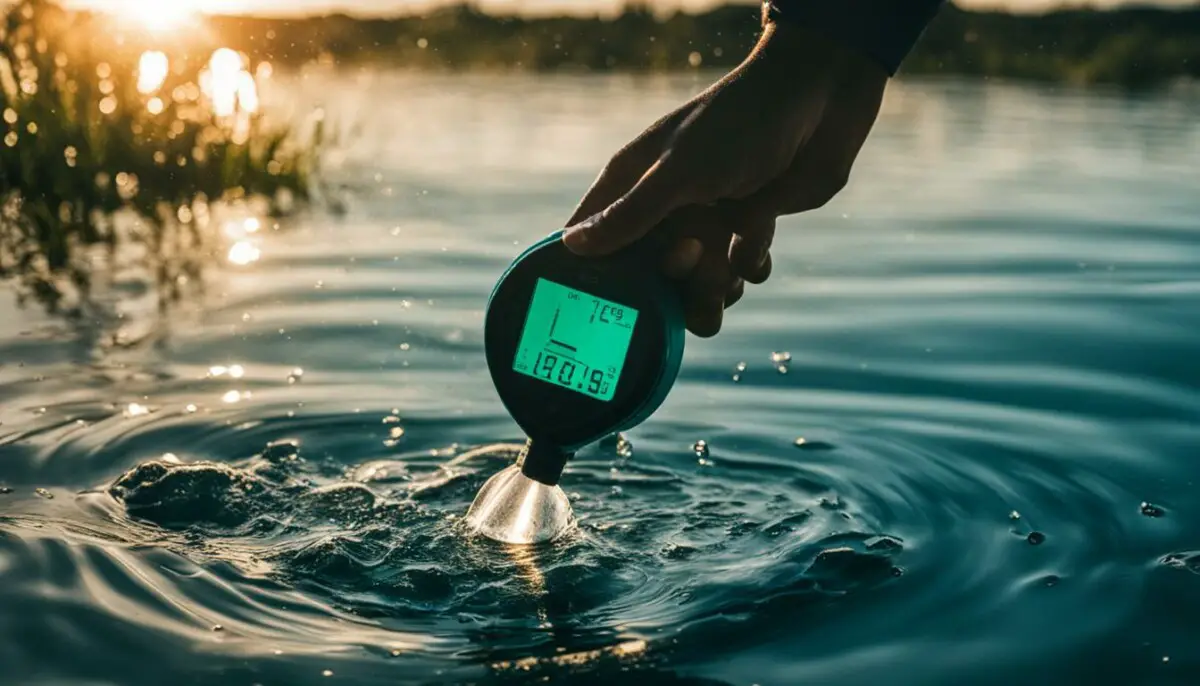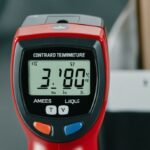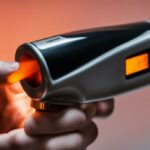Last Updated on 6 months by Francis
Are you wondering if an infrared thermometer can accurately measure the temperature of water? In this article, we will explore the capabilities of infrared thermometers when it comes to water temperature measurement and provide you with the best practices for obtaining accurate readings.
While infrared thermometers are known for their ability to measure surface temperatures without contact, they are not specifically designed for measuring the temperature of water. This is because infrared thermometers rely on measuring the infrared radiation emitted by an object, and this method is not suitable for accurately penetrating the liquid to measure its internal temperature.
However, there is a technique that can be used when measuring water temperature with an infrared thermometer. Before taking a measurement, it is important to vigorously stir the liquid to ensure that the surface temperature is the same as the temperature below the surface. By doing this, you can obtain a more accurate reading of the water temperature.
It is worth noting that an infrared thermometer should not be used to measure the temperature of boiling water. The steam released during boiling can affect the accuracy of the reading, making it unreliable.
Contents
Key Takeaways:
- An infrared thermometer is not designed to measure the temperature of water accurately.
- Stir the water vigorously before taking a measurement to achieve a more accurate reading with an infrared thermometer.
- Avoid using an infrared thermometer to measure the temperature of boiling water, as the steam can affect the accuracy of the reading.
What Type of Thermometer is Best for Water?
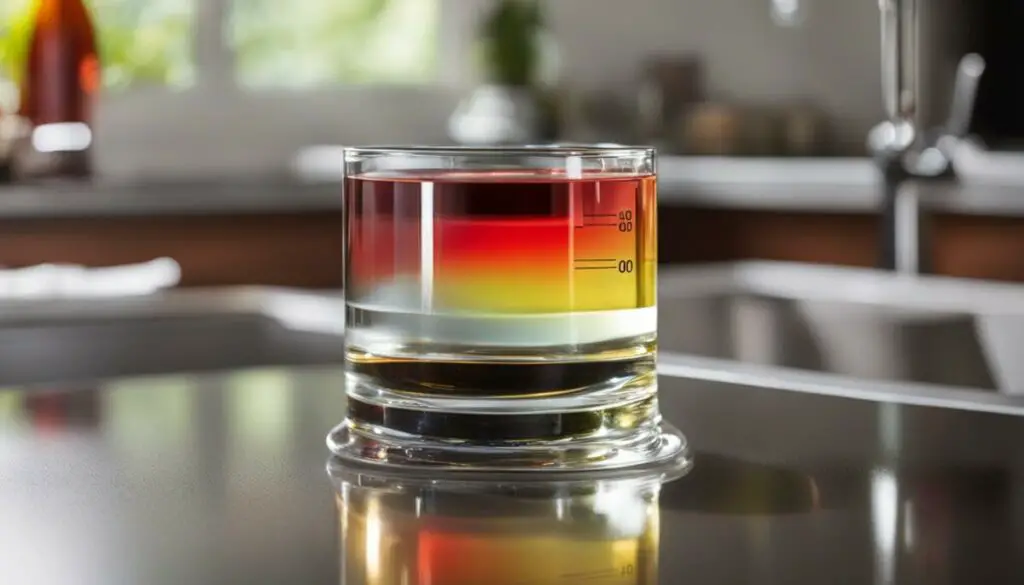
When it comes to accurately measuring water temperature, a floating thermometer is the ideal choice. Unlike an infrared thermometer, a floating thermometer is specifically designed to measure the temperature of liquids. It features a dial that stays on the water’s surface while the probe is submerged, allowing for precise temperature readings. This type of thermometer is particularly useful when precise temperature levels need to be achieved for cooking or other purposes.
Using a floating thermometer is straightforward. Simply place the thermometer in the water and let it float freely. The dial will display the temperature reading, providing you with an accurate measurement of the water temperature. This is especially important for applications where precise temperature control is necessary, such as brewing, candy making, or scientific experiments.
Advantages of Floating Thermometers:
- Accurate temperature measurement for liquids
- Easy to use and read
- Ideal for precise temperature control in cooking and scientific applications
- Durable and long-lasting
“A floating thermometer is the best choice for measuring water temperature accurately. It provides reliable temperature readings for various applications, ensuring precise temperature control and successful outcomes.”
By using a floating thermometer, you can ensure that you achieve the desired temperature for your specific needs, whether it’s brewing the perfect cup of tea or maintaining the ideal temperature for your aquarium. With its accuracy and ease of use, a floating thermometer is the preferred choice for measuring water temperature.
| Type of Thermometer | Advantages |
|---|---|
| Floating Thermometer |
|
Is an Infrared Thermometer Accurate on Liquid?

An infrared thermometer is a useful tool for measuring surface temperatures without contact, but its accuracy when it comes to liquid temperatures is a subject of debate. While it can provide an estimation of the surface temperature of a liquid, it cannot give an accurate reading of the liquid’s internal temperature. This is because infrared thermometers measure the radiation emitted by objects, and liquids may reflect or absorb this radiation differently depending on their composition and transparency.
When using an infrared thermometer to measure liquid temperatures, it is important to understand the limitations and factors that can affect accuracy. Although the stirring technique can help to ensure a more consistent surface temperature, it does not guarantee accurate readings of the liquid itself. External variables such as ambient temperature, humidity, and the specific model of the infrared thermometer can also impact the accuracy of the readings.
It is important to note that regular calibration of the infrared thermometer is crucial for obtaining accurate temperature measurements. Calibration helps to maintain the accuracy of the device by adjusting it to a known reference temperature. This ensures that any deviations or errors in the measurements are corrected, leading to more reliable readings. If accuracy is a critical factor in your temperature measurements, it is recommended to use other types of thermometers specifically designed for liquid temperature measurement.
Comparative Analysis of Liquid Temperature Measurement Methods
| Thermometer Type | Pros | Cons |
|---|---|---|
| Infrared Thermometer | – Non-contact measurement – Quick and convenient |
– Inaccuracy with liquid temperature – External variables impact accuracy |
| Floating Thermometer | – Specifically designed for liquid temperature measurement – Accurate readings submerged in liquid |
– Requires physical contact with liquid |
While an infrared thermometer can provide a general indication of a liquid’s surface temperature, it should not be solely relied upon for accurate liquid temperature measurements. For precise and reliable readings, it is advisable to use thermometers specifically designed for liquid temperature measurement, such as floating thermometers.
Can Infrared Thermometers Work Through Glass or Clear Plastic?
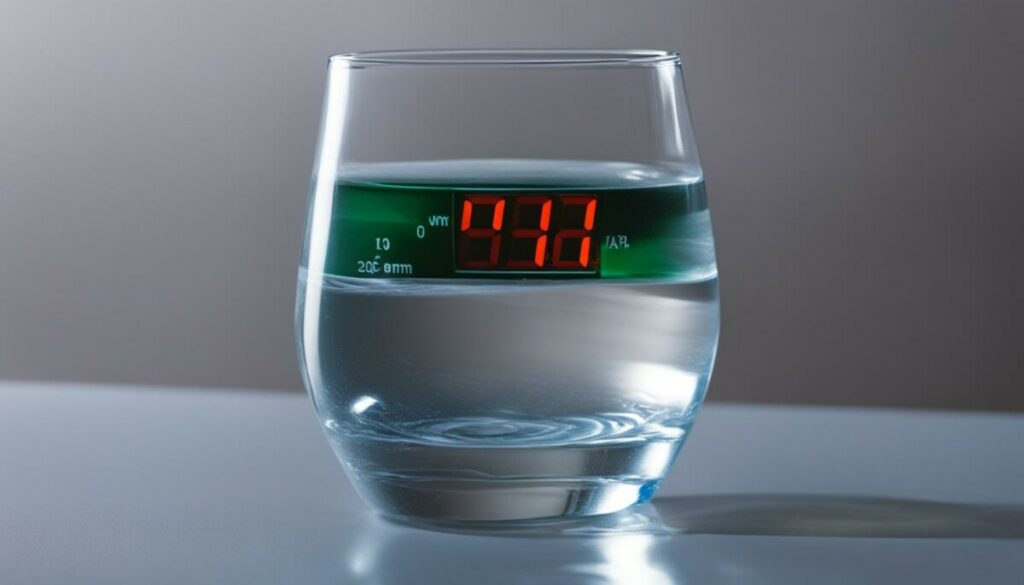
One common question that arises when using infrared thermometers is whether they can measure the temperature of an object through glass or clear plastic. Unfortunately, the answer is no. Infrared thermometers rely on detecting the thermal radiation emitted by an object to determine its temperature. However, when it comes to transparent surfaces like glass or clear plastic, these materials act as barriers and prevent the infrared thermometer from accurately measuring the temperature of the object behind them.
The infrared thermometer measures the temperature of the surface it is pointed at, which in this case would be the glass or clear plastic. Therefore, the temperature reading obtained will only reflect the temperature of the transparent surface itself, not the object behind it. So, if you want to measure the temperature of an object that is covered by glass or clear plastic, you will need to remove the barrier to obtain an accurate reading.
“Infrared thermometers cannot measure the temperature of an object through glass, clear plastic, or any other transparent surface.”
It is important to note that even if the infrared thermometer could detect the temperature of an object through glass or clear plastic, it would still be influenced by the temperature of the barrier. This would make it difficult to obtain an accurate measurement of the actual object temperature. Therefore, it is always recommended to ensure that there are no obstructions between the object and the infrared thermometer to obtain the most reliable and accurate temperature reading.
Comparison Table: Infrared Thermometers vs. Other Temperature Measurement Methods
| Infrared Thermometers | Contact Thermometers | |
|---|---|---|
| Accuracy | Varies depending on external variables and specific model | Highly accurate |
| Measurement Method | Non-contact | Contact |
| Measurement Speed | Almost instantaneous | Depends on the type of contact thermometer |
| Range | Varies depending on the type of infrared thermometer | Varies depending on the type of contact thermometer |
| Applications | Wide range of applications, including industrial, medical, and food safety | Wide range of applications, but limited by the need for contact |
As seen in the comparison table above, infrared thermometers offer the advantage of non-contact temperature measurement, making them suitable for various applications where contact with the object is not desirable or possible. However, their accuracy may vary, and they have limitations when it comes to measuring temperature through transparent surfaces like glass or clear plastic. In contrast, contact thermometers provide highly accurate temperature readings but require direct contact with the object being measured.
What Temperatures Do Infrared Thermometers Measure?
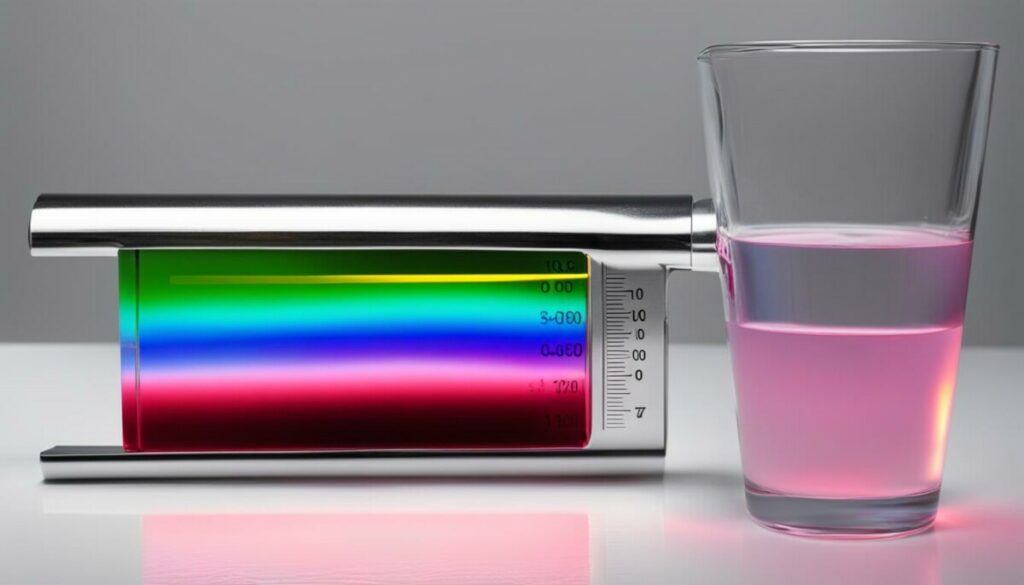
Infrared thermometers have different temperature ranges depending on their intended use. Clinical infrared thermometers, commonly used for measuring body temperature, typically have a temperature measurement range of 32 to 42 degrees Celsius. These thermometers are designed to provide accurate readings for medical purposes, allowing healthcare professionals to quickly assess a patient’s temperature without physical contact.
On the other hand, industrial infrared thermometers are built to withstand extreme temperatures and often have a wider temperature range. These thermometers can measure temperatures as low as -50 degrees Celsius and as high as 100 degrees Celsius, making them suitable for a variety of applications in industries such as manufacturing, HVAC, and automotive.
It is important to note that the temperature range of an infrared thermometer may vary depending on the specific model and manufacturer. It is essential to consult the user manual or product specifications to determine the exact temperature range of a particular infrared thermometer.
“The temperature measurement range of clinical infrared thermometers is typically 32 to 42 degrees Celsius, while industrial infrared thermometers can measure temperatures as low as -50 degrees Celsius and as high as 100 degrees Celsius.”
Understanding the temperature range of an infrared thermometer is crucial when selecting the appropriate device for your needs. Whether you require accurate body temperature readings or need to measure extreme temperatures in an industrial setting, there is an infrared thermometer available to suit your requirements.
Table: Comparison of Infrared Thermometer Temperature Ranges
| Infrared Thermometer Type | Temperature Range |
|---|---|
| Clinical Infrared Thermometer | 32 to 42 degrees Celsius |
| Industrial Infrared Thermometer | -50 to 100 degrees Celsius |
Best Practices for Using an Infrared Thermometer
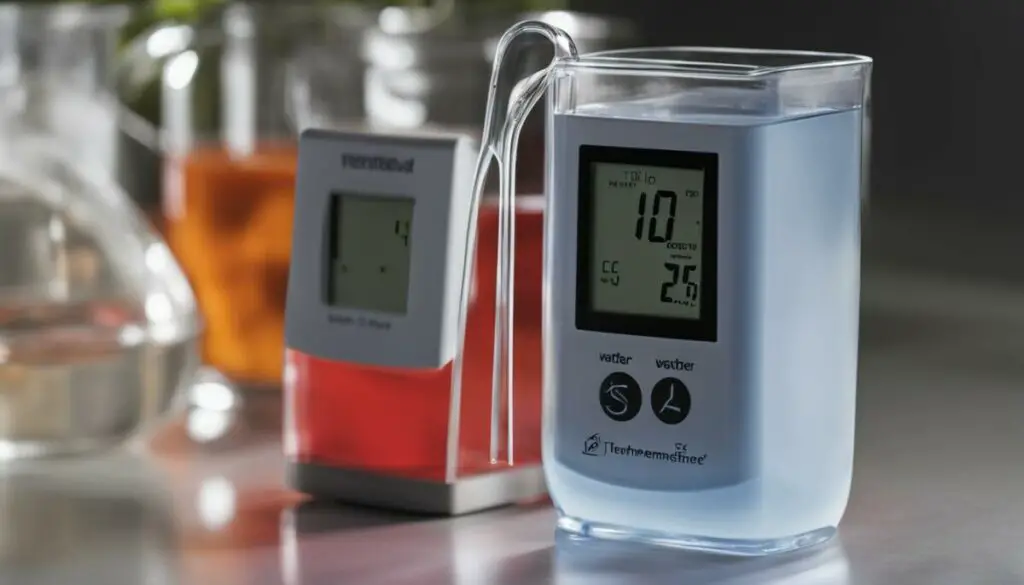
Using an infrared thermometer properly is essential to obtain accurate readings and ensure reliable temperature measurements. Follow these best practices to maximize the effectiveness of your infrared thermometer:
1. Maintain the Right Distance
When using an infrared thermometer, make sure to maintain the proper distance between the device and the object you are measuring. Typically, a distance of 12 to 18 inches is recommended for optimal readings. This allows the infrared sensor to capture the thermal radiation emitted by the object without any hindrance or interference.
2. Consider the Target Size and Angle
Take into account the size of the target object and the angle at which you are pointing the infrared thermometer. Larger objects may require a wider field of view, while smaller objects will require more precision in aiming. For accurate readings, try to hold the infrared thermometer perpendicular to the object being measured and keep a tight circle around the border of the object in focus.
3. Regularly Clean the Thermometer
Regular cleaning is crucial to maintain the accuracy of your infrared thermometer. Use a soft, lint-free cloth to wipe the device’s lens and sensor. Remove any dust, dirt, or debris that may accumulate on the surface, as these can affect the performance and accuracy of the thermometer. It is recommended to clean the device before and after each use.
By following these best practices, you can ensure that you are using your infrared thermometer correctly and obtaining accurate temperature readings. Remember to always refer to the manufacturer’s instructions for specific guidance on your particular model.
The Bottom Line

In summary, when it comes to measuring water temperature, an infrared thermometer may not be the most accurate tool. While it can measure the surface temperature of water with the stirring technique, it cannot provide an accurate reading of the overall liquid temperature. For precise temperature measurements, especially in cooking or scientific applications, it is recommended to use thermometers specifically designed for measuring water temperature, such as floating thermometers. These thermometers are designed to remain on the water’s surface while the probe is submerged, allowing for more accurate readings.
Although infrared thermometers have their uses, it is important to understand their limitations. They are not suitable for measuring the temperature of boiling water, as the steam released during boiling can affect the accuracy of the reading. Additionally, infrared thermometers cannot measure the temperature of liquids through glass or other transparent surfaces. The reading obtained will be that of the transparent surface, not the object behind it. Therefore, it is important to consider the target size, distance, and angle when using an infrared thermometer to ensure accurate temperature measurement.
To obtain the most accurate temperature readings with an infrared thermometer, it is essential to follow best practices. This includes measuring temperature from a distance without any contact between the thermometer and the object, as well as regularly cleaning the thermometer to remove any debris or particles that may affect its performance. By understanding the limitations of infrared thermometers and employing best practices, you can ensure more accurate temperature measurements in various applications.
How to Test a Catalytic Converter with an Infrared Thermometer?
Testing the efficiency of a catalytic converter in vehicles is crucial for maintaining optimal performance and reducing harmful emissions. One method to assess its functionality is by using an infrared thermometer. By measuring the temperature at the inlet and outlet pipes of the catalytic converter, you can gain valuable insights into its effectiveness.
To begin the testing process, ensure that the engine is at operating temperature and that the vehicle is safely positioned on a flat surface. Then, take your infrared thermometer and aim it at the inlet pipe of the catalytic converter. Record the temperature reading. Next, move the thermometer to the outlet pipe of the converter and take another reading. These two measurements will provide the basis for your analysis.
A properly functioning catalytic converter should exhibit a higher temperature at the outlet compared to the inlet. This temperature difference indicates that the converter is effectively converting harmful pollutants into less harmful substances. If the temperature at the outlet is similar to or lower than the temperature at the inlet, it may indicate a problem with the converter, such as a clogged or damaged catalyst.
By regularly testing your catalytic converter with an infrared thermometer, you can identify potential issues early on and take the necessary steps to address them. Remember to consult your vehicle’s manual or a professional mechanic for specific instructions and recommendations regarding testing and maintenance of your catalytic converter.
Table: Catalytic Converter Temperature Test Results
| Inlet Temperature | Outlet Temperature | Temperature Difference | Converter Efficiency |
|---|---|---|---|
| 300°C | 500°C | 200°C | Effective |
| 350°C | 350°C | 0°C | Potential Issue |
| 400°C | 550°C | 150°C | Effective |
The table above showcases the results of temperature tests conducted on different catalytic converters. A higher temperature difference between the inlet and outlet indicates a more efficient converter, while a temperature similarity or lower outlet temperature suggests a potential issue with the converter’s performance. Regular testing and monitoring can help ensure that your catalytic converter is functioning optimally, reducing pollution and maintaining your vehicle’s efficiency.
Conclusion
Infrared thermometers are versatile tools that can be useful in various applications. However, when it comes to measuring the temperature of water or other liquids accurately, they have their limitations. While an infrared thermometer can measure the surface temperature of water using the stirring technique, it cannot penetrate the liquid to measure its internal temperature. For precise temperature readings in cooking, scientific experiments, or other water-related activities, it is recommended to use thermometers specifically designed for liquid measurement, such as floating thermometers.
To obtain the most accurate temperature measurement, it is essential to follow best practices when using an infrared thermometer. This includes measuring temperature from a distance without contact, considering the target size, distance, and angle, and holding the device perpendicular to the object being measured. Regular cleaning of the infrared thermometer is also necessary to ensure optimal performance and accurate readings.
In conclusion, while infrared thermometers have their uses, they are not the ideal choice for measuring water temperature. Understanding their limitations and utilizing thermometers designed for liquid measurement will ensure precise temperature readings in various applications. So, when it comes to measuring the temperature of water or other liquids, it’s best to turn to specialized thermometers and leave the infrared thermometer for other temperature measurement needs.
FAQ
Can an infrared thermometer measure the temperature of water accurately?
No, an infrared thermometer is not designed to measure the temperature of water accurately. It can only measure the surface temperature of objects without contact.
How can I measure the temperature of water with an infrared thermometer?
Before taking a measurement, the water must be stirred vigorously to ensure that the surface temperature is the same as the temperature below the surface.
What is the best thermometer for measuring water temperature?
A floating thermometer is the best option for measuring water temperature accurately. It has a dial that stays on the water’s surface while the probe is submerged.
Are infrared thermometers accurate for measuring liquids?
No, infrared thermometers are not considered accurate for measuring the temperature of liquids. They can only measure the surface temperature using the stirring technique mentioned earlier.
Can infrared thermometers work through glass or clear plastic?
No, infrared thermometers cannot measure the temperature of an object through glass, clear plastic, or any other transparent surface. The temperature reading obtained will be that of the transparent surface, not the object behind it.
What temperatures do infrared thermometers measure?
The temperature range of infrared thermometers can vary depending on the type. Clinical infrared thermometers typically have a range of 32 to 42 degrees Celsius, while industrial thermometers can have a wider range from -50 to 100 degrees Celsius.
What are the best practices for using an infrared thermometer?
Always measure temperature from a distance without any contact, consider the target size, distance, and angle, and regularly clean the infrared thermometer to ensure accurate readings.
How can I test a catalytic converter with an infrared thermometer?
Aim the infrared thermometer at the inlet and outlet pipes of the catalytic converter to take temperature readings. A properly functioning converter will exhibit a higher temperature at the outlet compared to the inlet.
What is the conclusion on infrared thermometers for measuring water temperature?
Infrared thermometers are not the most suitable devices for accurately measuring the temperature of water. Floating thermometers are recommended for precise temperature measurement.

